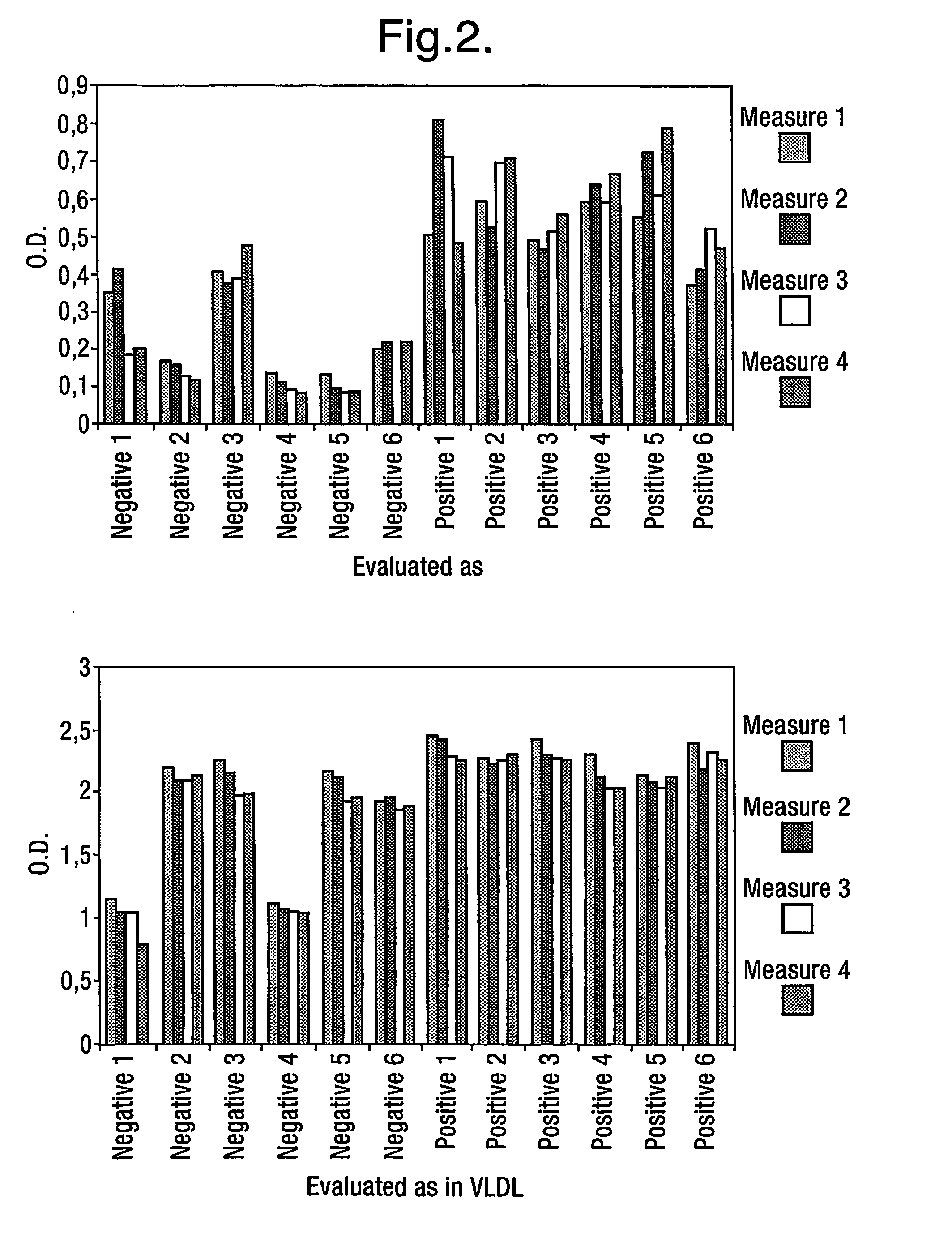Antibodies binding to a c-terminal fragment of apoliopoprotein e
a technology of apoliopoprotein and c-terminal fragment, applied in the field of antibodies, can solve the problems of organ failure or death, poor neurological recovery from a variety of acute brain injuries, and the presence of apoe4 isoforms,
- Summary
- Abstract
- Description
- Claims
- Application Information
AI Technical Summary
Benefits of technology
Problems solved by technology
Method used
Image
Examples
example 1
[0305] Antibodies that bind to ApoE found in plaques of amyloid disorders that do not bind to VLDL were selected from human phage antibodies in the Dyax phagemid library Fab300. Antibody diversity is present in the library used for the selections on CTD, the diversity in the light and heavy chains are composed as follows:
Heavy Chains
[0306] The heavy chain consists of one heavy chain gene segment (V3-23, or DP-47), in which diversity is created using synthetic oligonucleotides in certain positions in the HCDR1 and HCDR2. The distribution pattern is based on a diversity analysis of natural sequences. The appended HCDR3 diversity is derived from natural occurring sequences of the IgM-pool of B-cells from a series of autoimmune donors.
Light Chains
[0307] The light chain repertoire is derived from a pool of naturally rearranged light chains sequences, from the same source as the H-CDR3 diversity. This means that we can expect Vkappa and Vlambda genes, ba...
example 2
Preparation and Pretesting of Fibrils
[0312] Fibrils were extracted from spleen and kidney. Insoluble amyloid fibrils were extracted from human tissues by repeated rounds of mechanical homogenisation in cold 0.15M NaCl, 0.1% NaN3, with subsequent centrifugation in order to rescue the amyloid in the pellet. Finally the amyloid was dissolved / suspended in water and stored. Amyloid content was verified by Congo red staining of suspension smears. This method of extracting fibrils is known in the art, see for example Skinner et al. Prep. Biochem. 1982;12(5): 461-476. It was determined that bound and non-bound phage could be separated by washing with 5 Marvel-PBS-Tween (0.1%) washes, 2 PBS-Tween washes and 1 PBS wash.
example 3
Preparation and Pretesting of Biotinylated CTD (bCTD)
[0313] CTD having the amino acid sequence shown in SEQ ID NO: 1 was used. Biotinylation was performed with sulfo-NHS-SS-biotin according to the method described by Pierce using molar ratios of CTD / biotin of ½ and 1 / 10. SDS PAGE revealed that 100% of the material was labelled. In mass-spectrometry at a ratio of 1 / 10, three to five of the five possible biotinylation sites were labelled with biotin. At a ratio of ½ bCTD showed one or two biotins per molecule which is favourable for keeping the structure of the molecule. All CTD and NTD used were labelled with the same protocol at a ratio ½ and tested in SDS-page.
[0314] Coated bCTD was prepared by coating BSA with biotin, washing, adding streptavidin and, after washing again, adding b-CTD.
[0315] To produce denatured bCTD, bCTD was treated with urea and, after washing, bound to streptavidin on biotinylated BSA. To be sure that the bCTD binds and stays on the beads during urea treatm...
PUM
| Property | Measurement | Unit |
|---|---|---|
| Fraction | aaaaa | aaaaa |
| Fraction | aaaaa | aaaaa |
| Composition | aaaaa | aaaaa |
Abstract
Description
Claims
Application Information
 Login to View More
Login to View More - R&D
- Intellectual Property
- Life Sciences
- Materials
- Tech Scout
- Unparalleled Data Quality
- Higher Quality Content
- 60% Fewer Hallucinations
Browse by: Latest US Patents, China's latest patents, Technical Efficacy Thesaurus, Application Domain, Technology Topic, Popular Technical Reports.
© 2025 PatSnap. All rights reserved.Legal|Privacy policy|Modern Slavery Act Transparency Statement|Sitemap|About US| Contact US: help@patsnap.com



